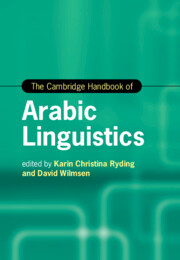Book contents
- The Cambridge Handbook of Arabic Linguistics
- Cambridge Handbooks in Language and Linguistics
- The Cambridge Handbook of Arabic Linguistics
- Copyright page
- Contents
- Figures
- Tables
- Notes on Contributors
- Acknowledgements
- Abbreviations
- Introduction
- Part I Arabic Applied Linguistics
- Part II Arabic Variation and Sociolinguistics
- Part III Theoretical and Descriptive Studies
- 12 Grammaticalization in Arabic
- 13 Arabic and Onomastics
- 14 The Intonation of Arabic
- 15 Case in Arabic
- 16 On Arabic Morphosyntax and Its Implications for the Theory of Generative Grammar
- 17 Arabic Morphology
- Part IV Arabic Computational and Corpus Linguistics
- Part V Arabic Linguistics and New Media Studies
- Part VI Arabic Linguistics in Literature and Translation
- Index
- References
16 - On Arabic Morphosyntax and Its Implications for the Theory of Generative Grammar
from Part III - Theoretical and Descriptive Studies
Published online by Cambridge University Press: 23 September 2021
- The Cambridge Handbook of Arabic Linguistics
- Cambridge Handbooks in Language and Linguistics
- The Cambridge Handbook of Arabic Linguistics
- Copyright page
- Contents
- Figures
- Tables
- Notes on Contributors
- Acknowledgements
- Abbreviations
- Introduction
- Part I Arabic Applied Linguistics
- Part II Arabic Variation and Sociolinguistics
- Part III Theoretical and Descriptive Studies
- 12 Grammaticalization in Arabic
- 13 Arabic and Onomastics
- 14 The Intonation of Arabic
- 15 Case in Arabic
- 16 On Arabic Morphosyntax and Its Implications for the Theory of Generative Grammar
- 17 Arabic Morphology
- Part IV Arabic Computational and Corpus Linguistics
- Part V Arabic Linguistics and New Media Studies
- Part VI Arabic Linguistics in Literature and Translation
- Index
- References
Summary
Usama Soltan brings his considerable expertise in generative theory to bear on Arabic morphosyntax in Arabic dialects and in Standard Arabic. He focuses on three topics: agreement phenomena, case marking, and negation structures. Using a Principles and Parameters approach, he discusses subject-verb agreement asymmetry (SVAA) in Standard Arabic and first conjunct agreement in both Standard Arabic and in Arabic vernacular. As he notes, both these topics have garnered the interest of generative linguists in terms of their wider impact on general grammatical theory. Case marking, his second topic, pertains to Standard Arabic only, but is rich in history, analysis, and speculative theory within the Arabic linguistic tradition. Soltan focuses on subject and object marking of NPs, noting the difference between case assigners for each and discussing the role of syntactic government. The morphosyntax of negation is Soltan’s third topic, contrasting the various negation processes of Standard Arabic with the extensive negative formulations of Cairene Egyptian Arabic (CEA) and finding ‘a rich ground for the analysis of clausal structure and its implications’ where the study of the syntax of modern Arabic dialects contributes significantly to general linguistic theory.
Keywords
- Type
- Chapter
- Information
- The Cambridge Handbook of Arabic Linguistics , pp. 371 - 404Publisher: Cambridge University PressPrint publication year: 2021
References
- 1
- Cited by

